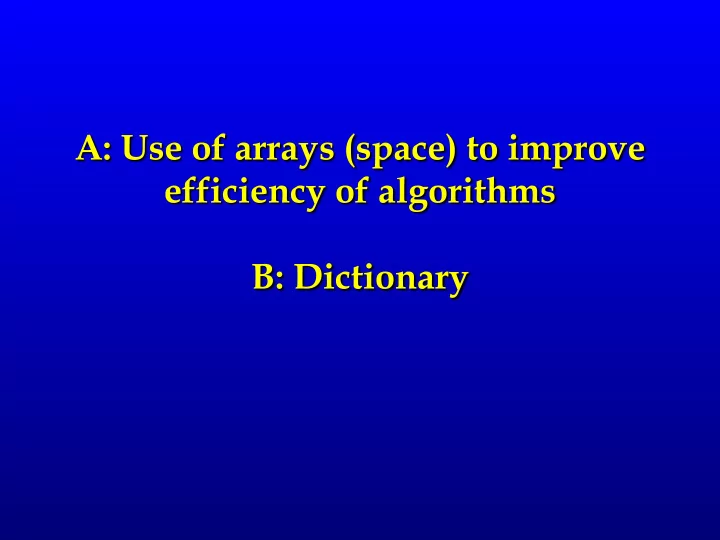

A: Use of arrays (space) to improve efficiency of algorithms B: Dictionary
Prime Numbers: • Given n find all prime numbers from 2 to n. • Generalises earlier strategy • One approach is to do test_prime(n) for all numbers upto n. – Not efficient
Prime Numbers: Seive of Eratosthenes • Avoid multiples of ALL smaller primes – cross (mark) them. • Algorithm: – For 2 <= x <= n • ...
Algorithm Seive of Eratosthenes
Algorithm Seive of Eratosthenes • Array of [2..n] • Initialise: – All numbers UNCROSSED – x = 2 • WHILE (x <= n) – Proceed to next uncrossed number x. This is a PRIME – CROSS all multiples of x
Algorithm Seive of Eratosthenes def sieve(n): save = [True] * (n+1) save[0]=save[1]=False i = 2 n = int(input('Give n:')) while (i*i <= n): primes=sieve(n) if (save[i]): for i in range(n+1): k = i*i if primes[i]: while (k<=n): print(i) save[k] = False k += i driver program i += 1 return save function sieve
Algorithm Seive of Eratosthenes • Time complexity – O(nloglogn) – proof is not in the scope here • Extra space – Need array of size ~ n • Can reduce extra space – segmented sieve
Fibonacci Numbers (Revisit) 0 n = 1 fib (n) = 1 n = 2 fib (n-1) + fib (n-2) n > 2 Recursive Algorithm Courtesy Prof PR Panda CSE Department IIT Dehi
Fibonacci Numbers (Revisit) fib (6) fib (5) fib (4) fib (4) fib (3) fib (3) fib (2) fib (3) fib (2) fib (2) fib (1) fib (2) fib (1) fib (2) fib (1) Courtesy Prof PR Panda CSE Department IIT Dehi
Fibonacci Numbers (Revisit) fib (6) fib (5) fib (4) fib (4) fib (3) fib (3) fib (2) fib (3) fib (2) fib (2) fib (1) fib (2) fib (1) fib (2) fib (1) Complexity O(2 n ) Courtesy Prof PR Panda CSE Department IIT Dehi
Fibonacci Numbers (Modified) • Based on memorization • Save result when first computed • Implement using an array (list)
Fibonacci Numbers (Modified)
Fibonacci Numbers (Modified) Complexity O(n)
Fibonacci Numbers (Modified) • fib(34): 3524578 – For the naïve recursive program the number of calls is 11405773 – For the modified program the number of calls is 65
Dictionary
Motivation • Consider that one wants to associate name (id) with grades of students. • Can obtain through two separate lists – names: [‘Mukesh’, ‘Sham’, ‘Arpita’, ‘Neha’] – grades:[‘A-’,’B’,’A’,’C’] • Separate list of same length for each item • Associated information stored across lists at same index • Retrieval and manipulation is not easy
Motivation • Consider that one wants to associate name (id) with grades of students. • Can obtain through two separate lists – names: [‘Mukesh’, ‘Sham’, ‘Arpita’, ‘Neha’] – grades:[‘A-’,’B’,’A’,’C’] • Separate list of same length for each item • Associated information stored across lists at same index • Retrieval and manipulation is not easy
Dictionary • Natural data structure to store pairs of data. – key (custom index by label) – value
Dictionary • Lookup: – similar to indexing into list – looks up the key and returns the value associated with the key – if key is not found returns error – print(grades[‘Sham’]) à B – print(grades[‘Amit’]) à Error
Dictionary • Other operations: – add an entry: • grades[‘Ankit’]=‘B-’ {'Mukesh': 'A-', 'Sham': 'B', 'Arpita': 'A', 'Neha': 'C', 'Ankit': 'B-'} – test if key is in dictionary • Mukesh in grades à returns True • Suresh un grades à returns False – delete an entry • del(grades[‘Neha’])
Dictionary • Other operations: – update an entry: • grades.update({‘Ankit’:‘B-’}) {'Mukesh': 'A-', 'Sham': 'B', 'Arpita': 'A', 'Neha': 'C', 'Ankit': 'B-'} • grades.update({‘Neha’:‘B-’}) {'Mukesh': 'A-', 'Sham': 'B', 'Arpita': 'A', 'Neha': ‘B-', 'Ankit': 'B-'} – get for getting the value for a key • grades.get(‘Mukesh’) à returns A – pop for removing a specific item • grades.pop(‘Neha’)
Dictionary • Other operations: – grades.keys() gives the keys, the order may not be guaranteed dict_keys(['Mukesh', 'Sham', 'Arpita', 'Neha']) – grades.values() gives the values, the order may not be guaranteed dict_values(['A-', 'B', 'A', 'C']) – grades.items() gives the contents dict_items([('Mukesh', 'A-'), ('Sham', 'B'), ('Arpita', 'A'), ('Neha', 'C')])
List vs Dictionary List Dictionary Ordered sequence of Matches keys to elements values Indices have an No order is order guaranteed Index is an integer Key can be any immutable type Dictionary is also known as associate array or hashmap in other programming languages
Fibonacci Numbers (Modified) Use of Dictionary Complexity O(n)
Recommend
More recommend